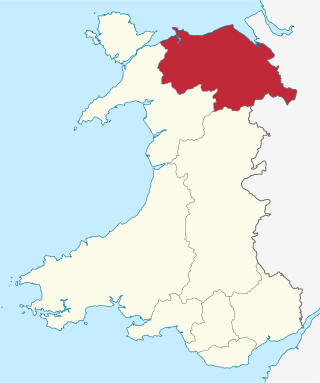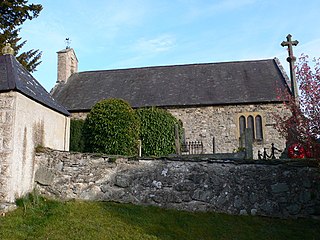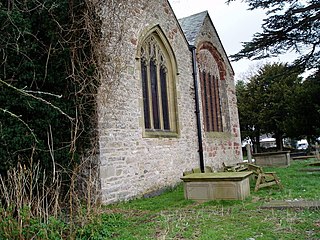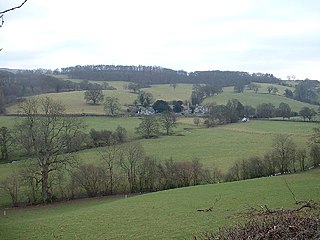
Ruthin is a market town and community in Denbighshire, Wales, in the south of the Vale of Clwyd. It is Denbighshire's county town. The town, castle and St Peter's Square lie on a hill, skirted by villages such as Pwllglas and Rhewl. The name comes from the Welsh rhudd (red) and din (fort), after the colour of sandstone bedrock, from which the castle was built in 1277–1284. The Old Mill, Ruthin, is nearby. Maen Huail, a registered ancient monument attributed to the brother of Gildas and King Arthur, stands in St Peter's Square.

Denbighshire is a county in the north-east of Wales. It borders the Irish Sea to the north, Flintshire to the east, Wrexham to the southeast, Powys to the south, and Gwynedd and Conwy to the west. Rhyl is the largest town, and Ruthin is the administrative centre. Its borders differ from the historic county of the same name.

The River Clwyd is a river in Wales that rises in the Clocaenog Forest 5 mi (8 km) northwest of Corwen. Its total length is 35 mi (56 km).

Clwyd is a preserved county of Wales, situated in the north-east corner of the country; it is named after the River Clwyd, which runs through the area. To the north lies the Irish Sea, with the English ceremonial counties of Cheshire to the east and Shropshire to the south-east. Powys and Gwynedd lie to the south and west respectively. Clwyd also shares a maritime boundary with Merseyside along the River Dee. Between 1974 and 1996, a slightly different area had a county council, with local government functions shared with six district councils. In 1996, Clwyd was abolished, and the new principal areas of Conwy County Borough, Denbighshire, Flintshire and Wrexham County Borough were created; under this reorganisation, "Clwyd" became a preserved county, with the name being retained for certain ceremonial functions.

Corwen is a town and community in the county of Denbighshire in Wales. Historically, Corwen was part of the county of Merionethshire. Corwen stands on the banks of the River Dee beneath the Berwyn mountains. The town is situated 10 miles (16 km) west of Llangollen and 13 miles (21 km) south of Ruthin. At the 2011 Census, Corwen had a population of 2,325, decreasing slightly from the 2001 population of 2,398, The community, with an area of 69.51 km2 (26.84 sq mi), includes Corwen and the surrounding villages of Carrog, Clawdd Poncen and Glyndyfrdwy. The Office for National Statistics identifies Corwen Built-up area with a 2011 population of 477 and an area of 0.25 km2 (0.097 sq mi).

Gwyddelwern is a small village and community of 508 residents, reducing to 500 at the 2011 census, situated approximately 2 miles (3.2 km) north of Corwen in Denbighshire in Wales. Historically the village was part of the Edeyrnion district of Meirionnydd. Edeyrnion was part of the Glyndŵr district of Clwyd from 1974 to 1996, when the area became part of the principal area of Denbighshire. The village straddles the A494 road.
The Vale of Clwyd is a tract of low-lying ground in the county of Denbighshire in north-east Wales. The Vale extends south-southwestwards from the coast of the Irish Sea for some 20 miles forming a triangle of low ground bounded on its eastern side by the well-defined scarp of the Clwydian Range and to the west by numerous low hills. The River Clwyd which rises within Clocaenog Forest, southwest of Denbigh, runs the full length of the vale. It is joined by the two major left bank tributaries of the River Clywedog and River Elwy and the smaller right bank tributary of the River Wheeler.

Llanfair Dyffryn Clwyd is a village and community in Denbighshire, Wales, situated in the Vale of Clwyd about one mile south of the town of Ruthin. By the 2001 census, it had 1048 residents and 50.6% of them could speak Welsh. The figures for the 2011 census were: population 1,053:Welsh speakers 46.9%. The age group with the highest percentage of Welsh speakers was the 15-year-olds where every one could speak it. The villages of Pentrecelyn and Graig Fechan are located in the community.

Llanfwrog is a village in Denbighshire, in northern Wales. It hosts a church, Llanfwrog Church of St Mwrog and St Mary. The sturdy medieval tower of St Mwrog's crowns the hill west of Ruthin, marking the point where town gives way to countryside. ‘Double-naved’ in the distinctive Clwydian style, the church is late medieval, but was much altered by Victorian restoration. The church was again restored in 1999. There are fine views from the circular 'Celtic' churchyard – St Mwrog was a little-known Welsh saint, perhaps from Anglesey. On a rise to the south by the road to Efenechtyd stands an ancient thatched and whitewashed house (private).

Aberwheeler is a village and community in the Welsh county of Denbighshire, located on the south bank of the River Wheeler, 4.2 miles (6.8 km) north east of Denbigh, 12.6 miles (20.3 km) north west of Mold and 11.0 miles (17.7 km) north of Ruthin. At the 2001 census the community had a population of 327, reducing to 298 at the 2011 census. The name has been Anglicised from the Welsh.

Cyffylliog is a village and community in Denbighshire, Wales. It is situated to the west of Ruthin on the banks of the River Clywedog. The community covers an area of 31.59 km2 and includes the hamlet of Bontuchel and a section of Clocaenog Forest. It had a population of 495 at the time of the 2011 census, a slight increase from 484 during the 2001 census. The name of the village means "place of pollard trees/stumps" and comes from the Welsh word cyffyll meaning stumps.

Nantclwyd Hall is a 17th-century Grade II* listed mansion near the village of Llanelidan, Denbighshire, Wales, built by the Parry family, and rebuilt by Eubule Thelwall and his wife Mary Parry, the heiress of the estate.

Nantclwyd y Dre is a Grade 1 listed house in Ruthin, Denbighshire. It is Wales's oldest dated timbered town house, and is owned by the county and open to the public as a historic house museum.

Clocaenog is a village and community in Denbighshire, north-east Wales. It lies on the outskirts of Ruthin and the Clocaenog Forest. The forest near the village has many walks of varying length and is one of the venues for the Wales Rally GB.

Llanynys is a hamlet and community in Denbighshire, north-east Wales;. It lies in the Vale of Clwyd, a few miles north of Ruthin, and includes the village of Rhewl.
Afon y Maes is a tributary river to the Clwyd and flows through the village of Llanelidan, Denbighshire, Wales. The river starts to the south of the village and joins up to the Clwyd on land behind Nantclwyd Hall, and therefore it is a relatively short river that starts and ends in the same town.

The Leyland Arms is a Grade II listed building in the community of Llanelidan near Ruthin, Denbighshire, Wales, which dates back to 1354. It was listed by Cadw.

Eubule Thelwall was a landowner and solicitor who held legal offices in North Wales and Cheshire, and the third son of John Thelwall of Bathafarn Park, Ruthin. In 1646 he served in the siege of Denbigh Castle and was sent by William Salesbury, the castle's governor, to Charles I to seek his permission to surrender. Thelwall married Marry Parry, the heiress of Nantclwyd estate in 1653 and instigated a complete rebuild of the building and of a second, smaller building in the nearby town of Ruthin: Nantclwyd y Dre, which is Wales's oldest dated timbered town house.
Llanrhydd or Llanrhudd is a parish one and a half miles south-west of Ruthin in Denbighshire, Wales; 'rhudd' being the Welsh name for 'red' – the colour of the local sandstone.






















